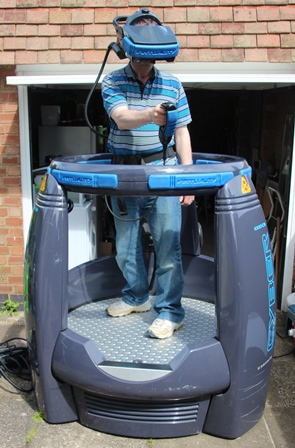Friends of mine will recall how disappointed I was when I first got my hands on an Oculus Rift (DK2). I basically told friends it was “shit”, and that I couldn’t believe how little progress there had been since virtual reality’s first golden years in the early 90’s.
 I was lucky enough to experience state of the art VR way back in 1992, in a system very similar to a Virtuix Omni, with a crazy (cool) looking headset and hand controller (pictured). This is one of the few pictures I could find online, for an otherwise forgotten system.
I was lucky enough to experience state of the art VR way back in 1992, in a system very similar to a Virtuix Omni, with a crazy (cool) looking headset and hand controller (pictured). This is one of the few pictures I could find online, for an otherwise forgotten system.
Its no exaggeration to say that the experience and graphics quality 23 years ago, were almost as good as the Oculus Rift DK2 is now. I realized I had been oversold on the hype about Oculus in the media, and the fact that Facebook had acquired it for $2 billion, which made me think that most who are writing about VR now, and the key figures involved, are probably not old enough to have experienced what was going on with virtual reality in the early 90’s.
It may surprise some that there were actually 3D virtual reality websites, long before Google was in existence. They worked off an HTML standard called VRML, which you could use to make fully functioning 3D websites, and a healthy community of developers behind it – myself included. It worked in your browser as a plugin to Netscape.
Going even further back, I was working on augmented reality in 1989 – when I first approached a company with the idea for VR goggles that had cameras in them, that would overlay computer graphics on your surroundings.
So you can understand perhaps I’m a tough sell…
Well I’m excited to say that with Oculus’s latest headset, the ‘Crescent Bay’ prototype, virtual reality is firmly back on track, and finally making progress again after a quarter-century gap in its development.
 I was able to try the Crescent Bay headset recently at CES, and it’s awesome. The world literally has no idea what is coming, very soon, and how much things are about to change.
I was able to try the Crescent Bay headset recently at CES, and it’s awesome. The world literally has no idea what is coming, very soon, and how much things are about to change.
The demos that Oculus laid on, were a strange but ultimately awesome mix of a dozen or so ‘scenes’, that put you smack in the heart of some pretty mind-blowing experiences. Suddenly finding yourself on a mesh skyscraper ledge, with an entire city – hundreds of feet below, was crazy. Finding yourself thrown into a full on Transformers assault, where you are being attacked in all directions on a Chicago-type street, was phenomenal.
There were more peaceful activities too – in one scene you could examine a Lilipution type city, with tons of activity going on, and you could literally bend down and look inside the windows. It was charming and utterly brilliant.
My biggest gripe with the current model, the DK2, has been its screen resolution (960 x 1080 per eye), which simply is not good enough when magnified to fill most of your field of view. It’s like playing Doom from the 1990’s, heavily pixellated – kind of hard to lose your sense of reality…
With the Crescent Bay prototype, resolution has made a substantial jump forward (nobody knows exactly – Oculus aren’t saying) but it feels about twice the resolution, perhaps 2000 x 2000 pixels per eye, and while the pixels are still visible, it is now ‘good enough’ to let go of the real world.
In years to come we’ll laugh at all this – as resolution will be indiscernible from reality.
Latency (how quick the visuals react to movement) is perfect. If I snapped my head from left to right – as fast as I could, the visuals reacted instantly and perfectly. This was a problem with earlier VR headsets, and caused people to get nauseous. No such problem here.
With screen resolution vastly improved, and latency no longer an issue, the weakest link in the chain is now field of view, or how much of your vision is filled by the screen. For a true VR experience, the field of view must be around the same or greater than your field of vision, which is around 170 degrees, more if you move your eyeballs around.
Sadly this aspect is going to be toughest for the likes of Oculus to solve (where is the Apple VR headset?), and the Crescent Bay has made very little progress here from the DK2, although the headset itself is much lighter. Field of view remains around 100 degrees.
This ultimately doesn’t matter – the experience is amazing as is, now that resolution is much higher. And it will only get better.
I’m excited for the first time in a long time about Virtual Reality – and buzzing about the possibilities. People thought TV was the drug of the nation. It will have nothing on when VR finally hits the mainstream…